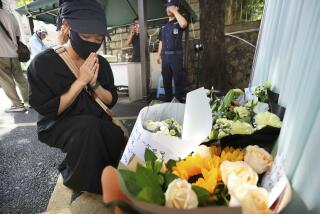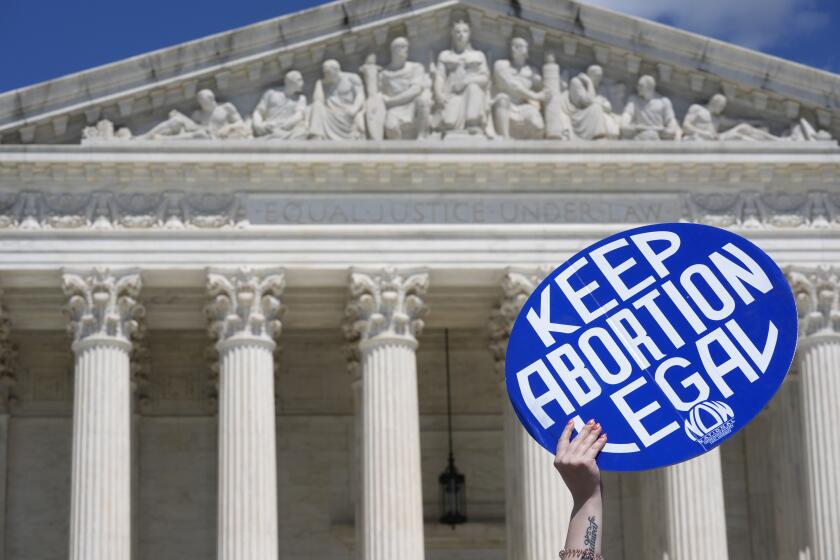What campus rape crisis?
It’s a lonely job, working the phones at a college rape crisis center. Day after day, you wait for the casualties to show up from the alleged campus rape epidemic -- but no one calls. Could this mean that the crisis is overblown? No. It means, according to campus sexual-assault organizations, that the abuse of coeds is worse than anyone had ever imagined. It means that consultants and counselors need more funding to persuade student rape victims to break the silence of their suffering.
It is a central claim of these organizations that between a fifth and a quarter of all college women will be raped or will be the targets of attempted rape by the end of their college years. Harvard’s Office of Sexual Assault Prevention and Response uses the 20% to 25% statistic. Websites at New York University, Syracuse University, Penn State and the University of Virginia, among many other places, use the figures as well.
And who will be the assailants of these women? Not terrifying strangers who will grab them in dark alleys, but the guys sitting next to them in class or at the cafeteria.
If the one-in-four statistic is correct, campus rape represents a crime wave of unprecedented proportions. No felony, much less one as serious as rape, has a victimization rate remotely approaching 20% or 25%, even over many years. The 2006 violent crime rate in Detroit, one of the most violent cities in the U.S., was 2,400 murders, rapes, robberies, and aggravated assaults per 100,000 inhabitants -- a rate of 2.4%.
Such a crime wave -- in which millions of young women would graduate having suffered the most terrifying assault, short of murder, that a woman can experience -- would require nothing less than a state of emergency. Admissions policies, which if the numbers are true are allowing in tens of thousands of vicious criminals, would require a complete revision, perhaps banning male students entirely. The nation’s nearly 10 million female undergraduates would need to take the most stringent safety precautions.
None of this crisis response occurs, of course -- because the crisis doesn’t exist.
So where do the numbers come from? During the 1980s, feminist researchers committed to the rape-culture theory discovered that asking women directly if they had been raped yielded disappointing results -- very few women said that they had been. So Ms. magazine commissioned University of Arizona public health professor Mary Koss to develop a different way to measure the prevalence of rape.
Rather than asking female students about rape per se, Koss asked them if they had ever experienced actions that she then classified as rape. One question, for example, asked, “Have you had sexual intercourse when you didn’t want to because a man gave you alcohol or drugs?” -- a question that is ambiguous on several fronts, including the woman’s degree of incapacitation, the causal relation between being given a drink and having sexual intercourse, and the man’s intentions. Koss’ method produced the 25% rate, which Ms. then published.
It was a flawed study on a number of levels, but the most powerful refutation came from her own subjects: 73% of the women whom the study characterized as rape victims told the researchers that they hadn’t been raped. Further, 42% of the study’s supposed victims said they had had intercourse again with their alleged assailants -- though it is highly unlikely that a raped woman would have sex again with the fiend who attacked her.
Despite all this, the numbers have stuck. Today, John Foubert, an education professor at William and Mary College (and founder of a group called One-in-Four, which works on sexual assault issues and has chapters on 17 campuses), says, “The one-in-four statistic has been replicated in several studies for several decades. To the extent that social science can prove anything, which I believe it can, the one-in-four statistic has been proven beyond all reasonable doubt. My instincts tell me that the statistic is actually much higher.”
Yet subsequent campus rape studies keep turning up the pesky divergence between the victims’ and the researchers’ point of view.
A 2006 survey of sorority women at the University of Virginia, for example, found that only 23% of the subjects whom the survey characterized as rape victims felt that they had been raped -- a result that the university’s director of sexual and domestic violence services calls “discouraging.” Equally damning was a 2000 campus rape study conducted under the aegis of the Department of Justice. Sixty-five percent of those whom the researchers called “completed rape” victims and three-quarters of “attempted rape” victims said that they did not think that their experiences were “serious enough to report.”
Believing in the campus rape epidemic, it turns out, requires ignoring women’s own interpretations of their experiences.
Nevertheless, none of the weaknesses in the research has had the slightest drag on the campus “anti-rape” movement, because the movement is political, not empirical. In a rape culture, which “condones physical and emotional terrorism against women as a norm,” sexual assault will wind up underreported, argued Carole Goldberg, the director of Yale’s Sexual Harassment and Assault Resources and Education Center, in a March 2007 newsletter. Campus rape centers and 24-hour hotlines, aided by tens of millions of dollars of federal funding, are ubiquitous.
Needless to say, those facilities don’t appear to get a tremendous amount of use. For example, Hillary Wing-Richards, the associate director of sexual-assault prevention at James Madison University, said the school’s campus rape “help line” gets a varying number of calls, some of which are “request-for-information calls” -- where to go, who to talk to and the like.
“Some months there are 10 and others, one or two,” she said.
Referring to rape hotlines, risk management consultant Brett Sokolow laments: “The problem is, on so many of our campuses, very few people ever call. And mostly we’ve resigned ourselves to the underutilization of these resources.”
Federal law requires colleges to publish reported crimes affecting their students. The numbers of reported sexual assaults -- the law does not require their confirmation -- usually run under half a dozen a year on private campuses, and maybe two to three times that at large public universities.
So what reality does lie behind the rape hype? I believe that it’s the booze-fueled hookup culture of one-night, or sometimes just partial-night, stands. Students in the ‘60s demanded that college administrators stop setting rules for fraternization. The colleges meekly complied and opened a Pandora’s box of boorish, promiscuous behavior that gets cruder each year.
This culture has been written about widely. College women -- as well as men -- reportedly drink heavily before and during parties. For the women, that drinking is often goal-oriented, suggests Karin Agness, a recent University of Virginia graduate and founder of NeW, a club for conservative university women: It frees the drinker from responsibility and “provides an excuse for engaging in behavior that she ordinarily wouldn’t.” Nights can include a meaningless sexual encounter with a guy whom the girl may not even know.
In all these drunken couplings, there may be some deplorable instances of forced and truly non-consensual sex. But most campus “rape” cases exist in the gray area of seeming cooperation and tacit consent, which is why they are almost never prosecuted criminally.
“Ninety-nine percent of all college rape cases would be thrown out of court in a twinkling,” observes University of Pennsylvania history professor Alan Kors.
Many students hold on to the view that women usually have the power to determine whether a campus social event ends with intercourse. A female Rutgers student expressed a common sentiment in a university sexual-assault survey: “When we go out to parties and I see girls and the way they dress and the way they act ... and just the way they are, under the influence and um, then they like accuse them of like, ‘Oh yeah, my boyfriend did this to me’ or whatever, I honestly always think it’s their fault.”
But suggest to a rape bureaucrat that female students share responsibility for the outcome of an evening and that greater sexual restraint would prevent campus “rape,” and you might as well be saying that women should don the burka.
College officials have responded to the fallout of the college sexual revolution not with sound advice but with bizarre and anachronistic legalisms for responding to postcoital second thoughts.
University of Virginia students, for example, may demand a formal adjudication before the Sexual Assault Board; they can request a “structured meeting” with the Office of the Dean of Students by filing a formal complaint; or they can seek voluntary mediation.
Risk-management consultants travel the country to help colleges craft legal rules for student sexual congress.
“If one partner puts a condom on the other, does that signify that they are consenting to intercourse?” asks Alan D. Berkowitz, a campus rape consultant. Short of guiding the thus-sheathed instrumentality to port, it’s hard to imagine a clearer signal of consent, although Berkowitz apparently finds it “inherently ambiguous.”
And even as the campus rape industry decries alleged male predation, a parallel campus sex bureaucracy sends the message that students should have recreational sex at every opportunity.
New York University offers workshops on orgasms and “Sex Toys for Safer Sex” (“an evening with rubber, silicone and vibrating toys”) in residence halls and various student clubs. Brown University’s Student Services helps students answer the compelling question: “How can I bring sex toys into my relationship?” Princeton University’s “Safer Sex Jeopardy” game for freshmen lists six types of vibrators and eight kinds of penile toys.
Why, exactly, are schools offering workshops on orgasms? Are students already so saturated with knowledge of the evolution of constitutional democracy, say, that colleges should reroute their resources to matters available on porn websites?
Remarkably, many students emerge from this farrago of mixed messages with common sense intact.
In a November column in the University of Virginia’s student newspaper, a third-year student gave the real scoop on frat parties: They’re filled with men hoping to have sex. Rather than calling these men “rapists,” columnist Katelyn Kiley offered some practical wisdom to the women trooping off to Virginia’s fraternity row:
“It’s probably a good idea to keep your clothes on, and at the end of the night, to go home to your own bed. Interestingly enough, that’s how you get [the guys] to keep asking you back.”
Maybe such young iconoclasts can take up another discredited idea: College is for learning. Fighting male dominance or catering to the libidinal impulses released in the 1960s are sorry substitutes for the pursuit of knowledge.
More to Read
Sign up for Essential California
The most important California stories and recommendations in your inbox every morning.
You may occasionally receive promotional content from the Los Angeles Times.










